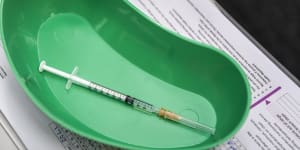But while state governments have restricted clinics to between five and 50 doses of the highly anticipated vaccine each month,the federal government maintains there is no shortage and the rollout is proceeding as planned.

The highly anticipated Shingrix vaccine is difficult to find after GP’s orders were restricted.Justin McManus
Federal Health Minister Mark Butler announced in October that.
The new two-dose Shingrix vaccine provides 10 years of protection against shingles,a painful,blistering rash caused by the reactivation of the virus that causes chickenpox. The viral infection can lead to painful nerve damage,particularly for vulnerable people.
Dr Rodney Pearce,a South Australian GP and chair of the Immunisation Coalition advocacy group,said some GP clinics had been told orders of the new shot would be limited to five doses.
“The advertising and the promotion said that anyone who wanted it and was eligible could have it from November,and they can’t,” he said.
Pearce said the Immunisation Coalition had been “pretty critical” of the rollout from the outset,expressing concern about the federal government delegating responsibility for distributing the vaccines to the states,and there being no dedicated aged care plan.
While many vaccines,including the annual flu shot,are delivered using a state-federal partnership,Pearce said the model used to distribute COVID-19 vaccines could have been more effective.
Dr Rebekah Hoffman,NSW and ACT chair of the Royal Australian College of General Practitioners,said some GPs in her state had been only able to order 15 to 20 Shingrix doses.
“When we talk about vaccinating all of our patients aged over 65,it doesn’t even touch the sides,” she said.
Dr Shea Wilcox from the Inner North Medical Clinic in Melbourne said his Brunswick East clinic had been limited to 20 doses in November and 40 in December.
“There’s 40,000 people on our books,” Wilcox said. “Ours ran out the door.”
On Thursday,he was still not able to make orders for January and had not received information about supply.
Sally Davis received her first dose at her Armadale GP clinic in Melbourne and was disappointed she had no certainty of when a second dose would be available.
“They can’t tell me when I can get my next one because they don’t know,” Davis said.
A spokesperson for the federal health minister maintained there was no shortage of the vaccine.
“The Australian government has not restricted ordering for vaccines,nor has it asked the states or territories to restrict ordering,” they said.
“Requests for additional vaccines can be made directly to the relevant state or territory health department via normal vaccine ordering systems.”
The spokesperson said the vaccine had been purchased using Australian Bureau of Statistics population estimates for the eligible cohorts,with 1.6 million doses expected to be distributed to providers between now and June 30 next year,including 500,000 doses available before the end of the year.
However,spokespeople for both the Victorian and NSW state governments said they had implemented the order limits in response to limited supply.
“The Shingrix program commenced on 1 November 2023,and we were advised supplies would be limited until 2024,” a Victorian spokesperson said,noting the Commonwealth was responsible for procuring vaccine supplies and allocating them proportionately between states and territories.
“Our immunisation providers are encouraged in the meantime to prioritise high-risk patients who wish to receive the vaccine.”
A spokesperson for NSW Health said it had limited GPs’ December orders to 20 to 50 shots a month to ensure an equitable supply across the state.
Both spokespeople said the states would review the limits based on ordering patterns and available supply.
Hoffman said the college had been assured supply would improve in February or March 2024,but for the moment clinics needed to prioritise their highest needs patients.
But Pearce said it should not be the responsibility of GPs to determine which of their eligible patients deserved a free shot,noting some would have delayed patients’ vaccinations because they expected Shingrix would be available.
Shingrix,which was previously only available privately at a cost of $560,replaced the Zostavax vaccine on the National Immunisation Program,which was free only for adults aged 70 to 79. Providers were instructed to stop using Zostavax at the end of October.
“[GPs] have become the gatekeepers and the providers of these things,when really that should be[vaccine advisory group] ATAGI’s role,” he said.
“I now need to make the decision as to whether my 65-year-old patient gets it or my diabetic patient gets it.”
GSK,the pharmaceutical company that developed the vaccine,confirmed 500,000 doses would be provided to Australia by the end of the year with a further 1.1 million on the way by June.
“GSK is working with the Australian government to ensure this vaccine is accessible to Australians who need this vaccine,when and where they need it,” a spokesman said.
Start the day with a summary of the day’s most important and interesting stories,analysis and insights..